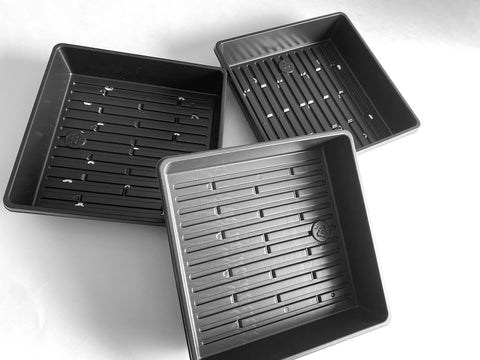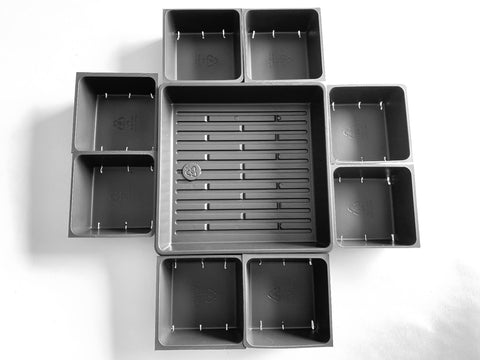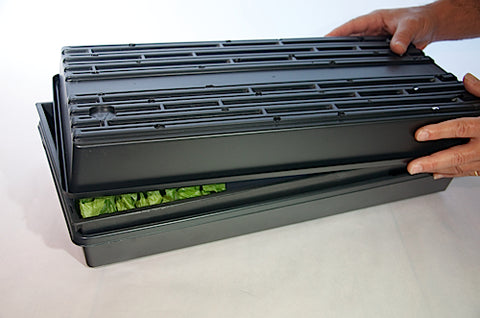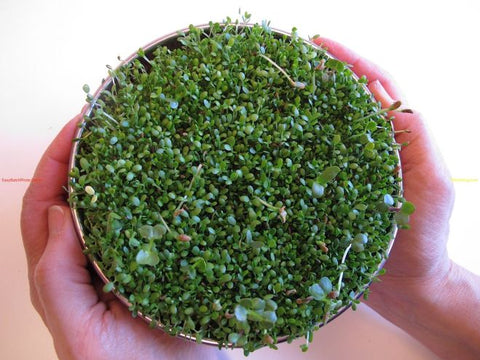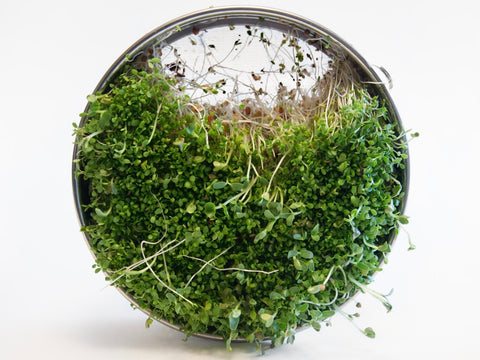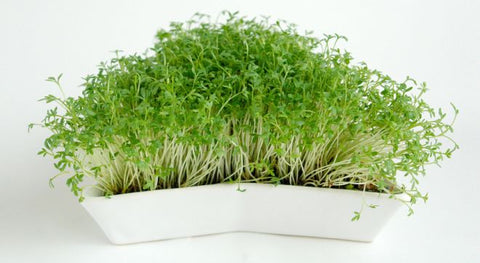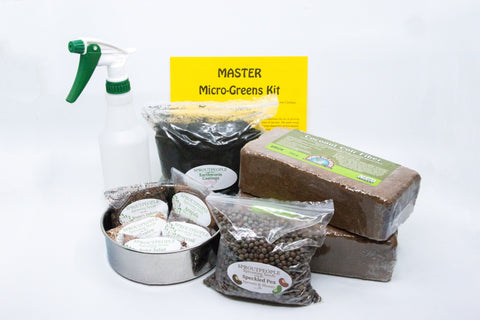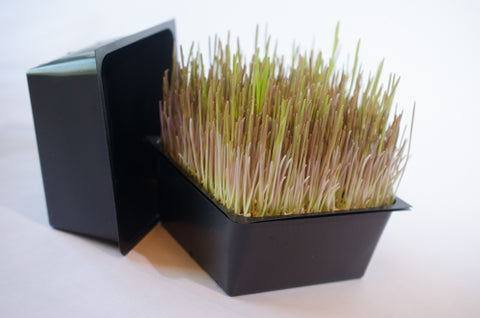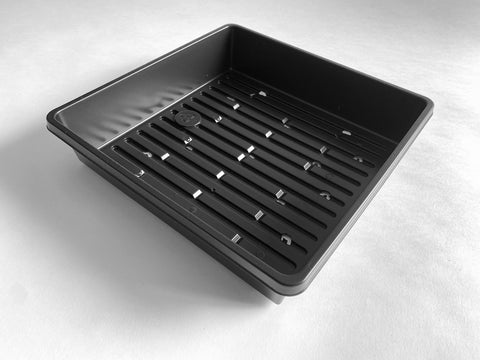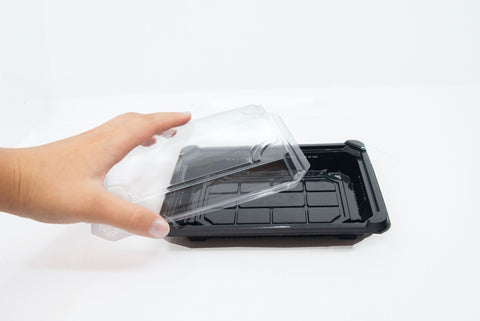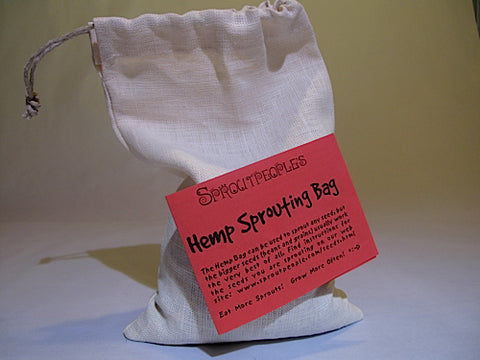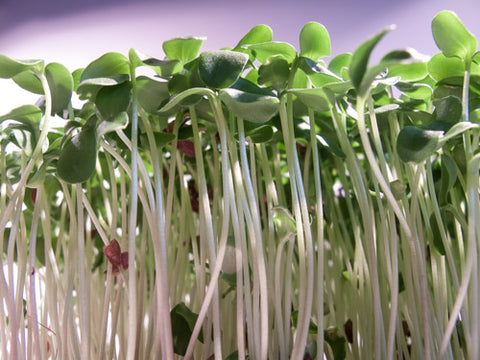
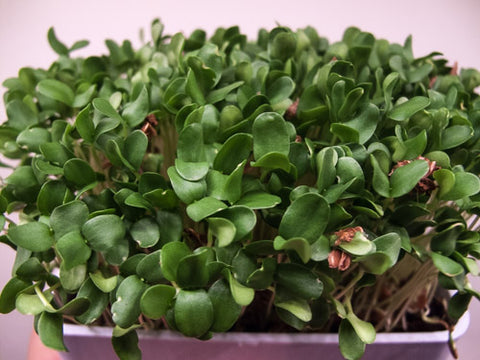
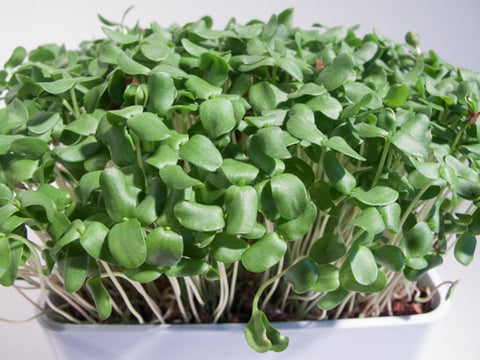
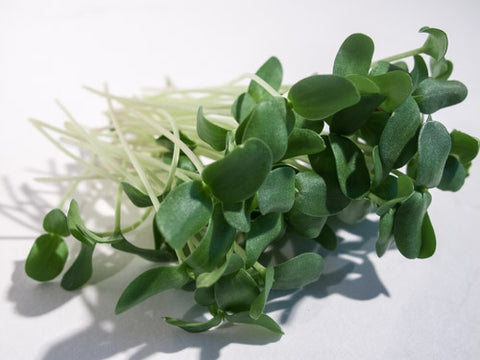
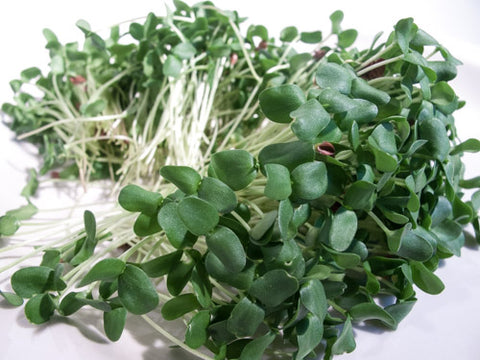
Flax Micro-Greens
Brown and/or Golden Flax
A tall and lanky Micro-Green, Flax is desired by many for the nutritional qualities of the seed. The seed is often used for teas which aid intestinal health, added to cereals, breads or just ground up in healthy drinks. Whether you are growing Flax or just looking for seed to eat - these are beautiful seeds!
Vitamins A, B, C and E
Calcium, Iron, Magnesium, Niacin, Phosphorus, Potassium
All Essential Amino Acids
Antioxidants
Protein: 20-25%
Light and tender.
The time it takes to grow a finished 5 - 14 days, or other crop (Micro-Greens, Grass, Greens) from a dry Seed. Note: This "finished" Sprout is our preference. you may grow them for as long as you want! In fact, we suggest that you taste them at every rinse to discover when you like them best.
How to Grow Flax Micro-Greens
- Plant 1-2 teaspoons of seed (for a 5x5 inch Tray) on thoroughly moistened medium.
- Cover your crop with another tray, or a plate - to keep light out and moisture in.
- Keep your medium moist by watering lightly as needed. Don't drench!
Use Coconut Coir and you likely won't have to water at all after planting! - When your plants have begun to show leaves, remove cover and move your crop to a well lit location.
- Harvest when the leaves are open and an inch or three tall (day 5-14).
- Cut just above the medium, with a scissors or sharp knife.
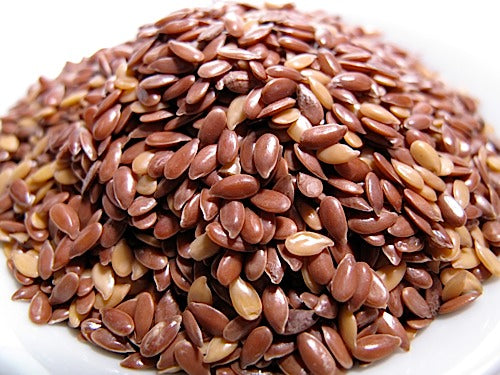
Flax seed is gorgeous.
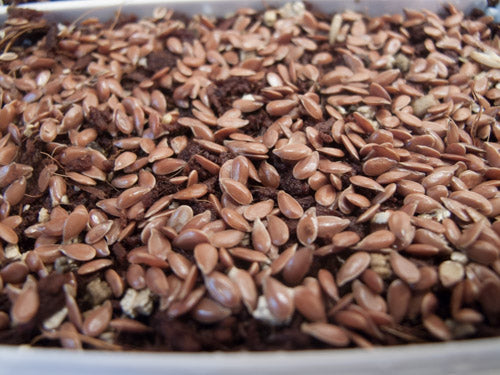
Spread it atop the thoroughly moistened perfect Medium - our mix is 80% Coconut Coir, 20% Earthworm Castings, and 20% Vermiculite. Thoroughly moist means saturated, but not dripping.
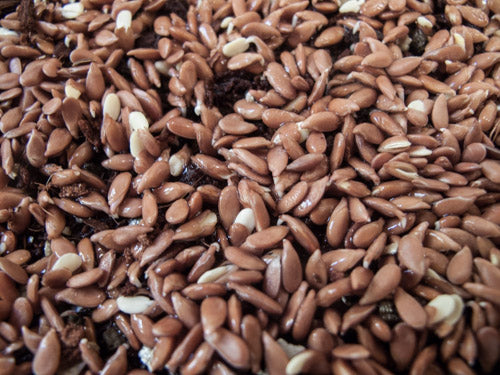
12 hours later....
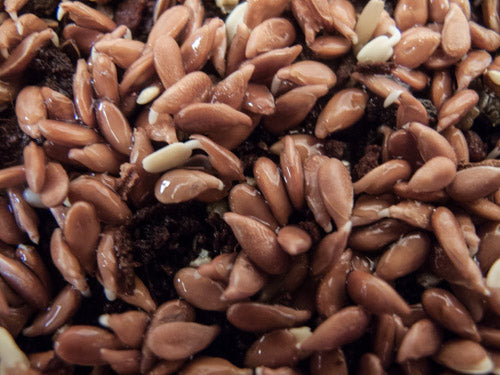
12 hours later....
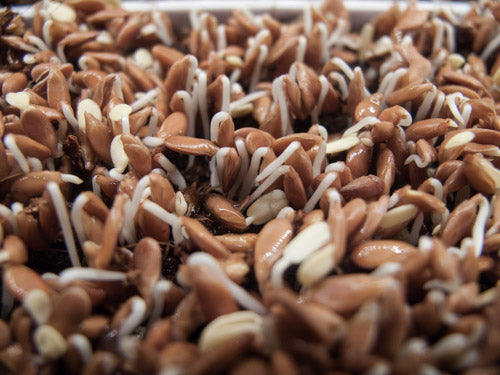
12 hours later....
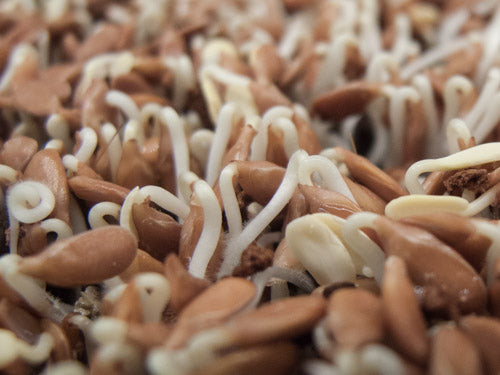
A closer look.
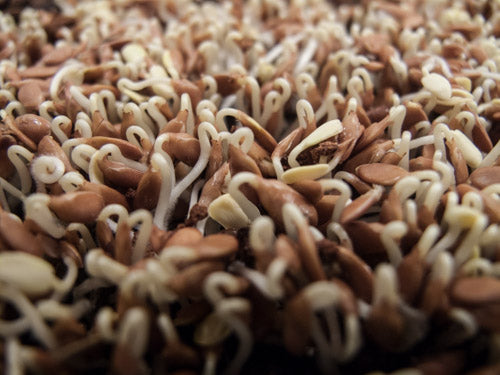
12 hours later....
It's a bit early, but I uncovered our crop after taking this picture.
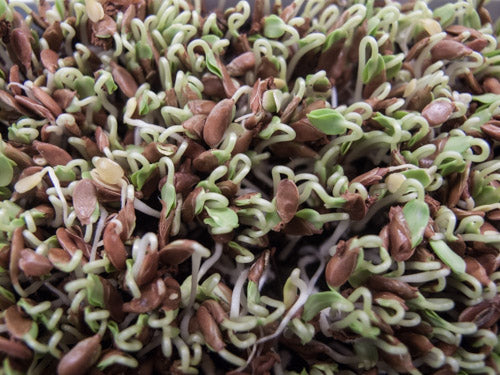
12 hours later....
Photosynthesis happens!
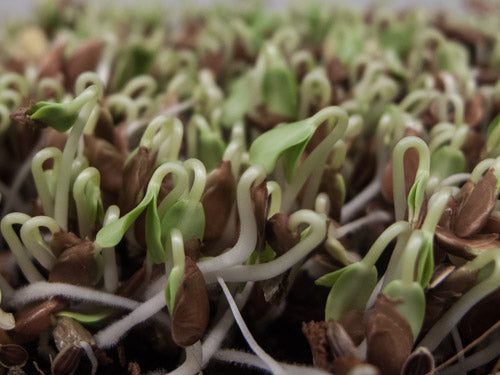
A closer look.
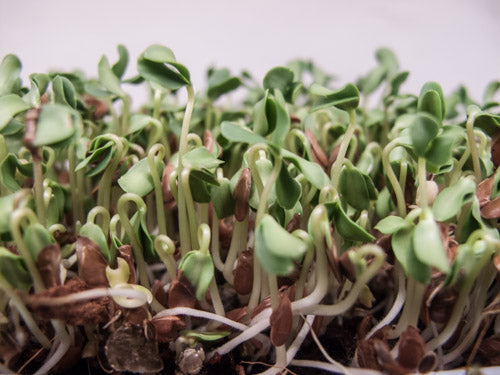
12 hours later....
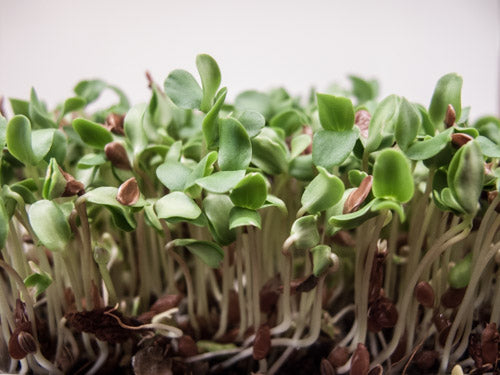
12 hours later....
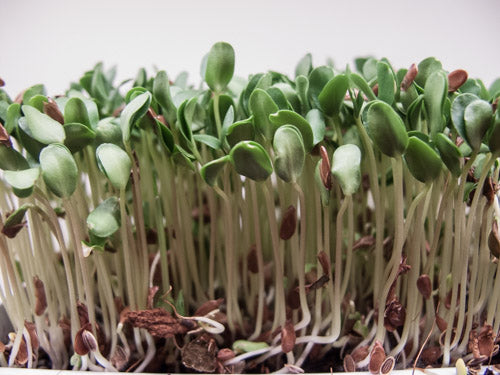
12 hours later....
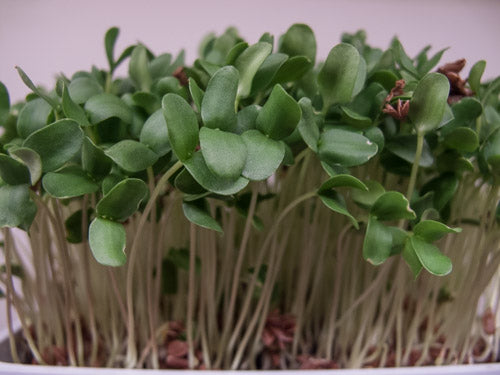
12 hours later....
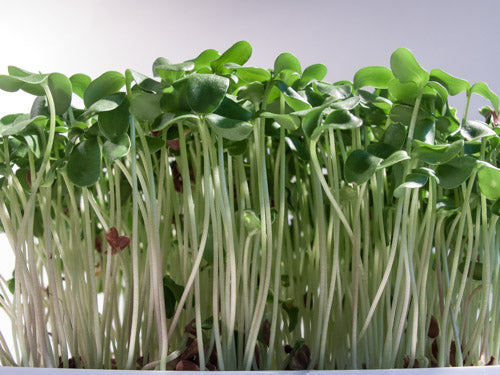
12 hours later....
Harvest by cutting the plants off close to the Medium.

Flax seed is gorgeous.

Spread it atop the thoroughly moistened perfect Medium - our mix is 80% Coconut Coir, 20% Earthworm Castings, and 20% Vermiculite. Thoroughly moist means saturated, but not dripping.

12 hours later....

12 hours later....

12 hours later....

A closer look.

12 hours later....
It's a bit early, but I uncovered our crop after taking this picture.

12 hours later....
Photosynthesis happens!

A closer look.

12 hours later....

12 hours later....

12 hours later....

12 hours later....

12 hours later....
Harvest by cutting the plants off close to the Medium.
Yields approximately as many Micro-Greens (by weight) as seed "planted" We put quotes around Planted because the seeds are always spread atop a medium - not planted under.
This is a mucilaginous seed. Do NOT soak it unless you are performing an experiment!
(see Notes (below) for variations)
Grow these on soil or Baby Blanket (a soilless medium) in a Tray, on a Hemp Bag, in our Compostable Tray (which holds Baby Blanket very nicely) or on virtually any moisture retaining medium (theoretically as minimal as paper towel or fabric - like cheesecloth) you can think of.
Thoroughly moisten the Medium upon which you are going to grow. Whether you are using a Hemp Bag, Baby Blanket, or another medium - lay it on a plate or in a pan or something - so that you don't end up watering your counter. If you are using a Tray with drainage slits to hold your medium, put it on a plate or in a solid (Drip) Tray - or use a plate or pan to capture the water runoff.
Spread seeds sparsely on your thoroughly moistened medium. There should be a bit of space around each seed but you are not expected to place them one at a time - just spread them out as much as you can and as evenly as you can, within reason.
You may cover your seeds: If planting on soil or another medium in a Tray use another identical tray - up side down. If using a Compostable Tray you can cover the tray for the first 2-3 days. If using a Hemp Bag, Baby Blanket, or another medium - be creative. If it's on a plate then use an identical plate (upside down) as a cover. It is not mandatory when growing Micro-Greens to cover them at all. Experiment for yourself and see what works best in your climate/location.
Place your Micro-Garden in a low-light, room temperature location (70° is optimal).
Keep the medium moist - but not soggy - by watering or misting with a Spray Bottle every day.
When your plants grow up and begin to shed their hulls they are ready for light so move them (if necessary) to a well lighted location. If you go with sunlight be prepared to water more frequently. Room light will usually do quite nicely - and will not dry out your medium as quickly.
Keep the medium moist but not soggy by watering regularly. Water from the side if possible to prevent injuring the tiny plants - especially if you are not using a Spray Bottle.
When your plants have open leaves which are green, they are done.
Harvest
Cut the plants just above the medium upon which they have grown. During the final 8-12 hours minimize the surface moisture of your plants - they will store best in your refrigerator if they are dry to the touch. So if you water try to keep the water off the plants - just water the medium.
When you are ready to store them (I'll remind you that these degrade fast, so eat them instead of storing them if you can), if they are still damp - lay them between some paper towels or anything you prefer, and dry them very gently. Transfer your crop to a plastic bag or the sealed container of your choice - glass is good. We sell an amazing Produce Storage Bag that actually extends the shelf life of produce, if you're interested in the best of the best =;-) Whatever you store them in; put them in your refrigerator - if you must.
* Dry Seed Volume
See our Notes (below) for Variations.
If using Sproutpeople's Single Harvest Pack and a 5x5 inch Tray; use the whole bag.
2 Teaspoons for our little 5 inch tray. 2 scant Tablespoons for an 10 inch square tray. 4 Tablespoon for an 10 x 20 inch tray.
The first time you grow these you should consider giving quite a bit of space to each seed just to familiarize yourself with the plants' habit. Our suggested Dry Seed Volume will provide you with this space.
To learn what mucilaginous really means; take one Flax seed and put a drop or 2 of water on it. Wait for 5 minutes and try to pick the seed up =:-} That's mucilaginous!
If you are curious about sprouting Flax, Read This.
Sproutpeople and Micro-Greens
We first grew Micro-Greens back in 1994. We were way ahead of the curve. Nobody was interested in them - not our farmers market customers, not our food stores (co-ops, natural food stores and grocery stores we delivered to every week), not our restaurants, nobody! That did change some as the years passed, but we were always Sprout People first. Frankly, we prefer Sprouts to Micros because we find them plumper and more texturally pleasing - but we keep working with them. Some seeds (especially mucilaginous seeds) won't grow as sprouts and Micro-Greens are SO gorgeous and offer a lot of unique and really cool possibilities.
Soaking and Pre-Sprouting
Though our instructions (in the Growing Instructions Tab - to the left) used to suggest these steps (for non-mucilaginous seeds), we have found
them less and less necessary as we've worked with Micro-Greens.
We skip both now, concentrating first on thoroughly moistening
our medium. We then plant the seeds (which are just spread atop that thoroughly moistened medium), and mist them with a Spray Bottle, when appropriate. We then cover our planted seeds.
We mist them with a Spray Bottle at least once a day until they sprout, and then bury their roots in the medium. During those first 2-3 days we are
misting heavily for some - - not at all for others.
We uncover the crops at different stages, depending on what we are doing with a particular crop. Keep reading to learn more.
Fertilizing Micro-Greens
When growing on a soilless medium like Hemp Felt - it is advisable to use Liquid Kelp Feritlizer
to give your plants
additional nutrients to draw upon. When we use Kelp we dilute 1 tsp. in 1 quart of water (this is a higher concentration than the product label calls for).
We use it in a Spray Bottle or by watering the medium directly. We use it every time we water.
The perfect container for these soilless mediums is our inexpensive Compostable Tray.
If you plant on soil - or better yet with Coconut Coir (our FAVorite), mix in 25% Earthworm Castings
for the ultimate nutrient rich, moisture retaining planting medium. Mix them together thoroughly before moistening.
Micro-Green Variations
There are varying opinions of what constitutes a Micro-Green. Traditionally it is just a plant grown to
the Cotyledon (first leaf) stage, and cut above the medium upon which it is
planted.
When we grow to this stage; we either grow on Hemp Felt, soil (any kind will do) , or our favorite -
Coconut Coir. Hemp Felt is less messy and works fine and dandy. We cut a piece to fit a
plate, then we follow our own instructions for keeping the medium and seeds-sprouts thoroughly moist. We use another of the same size plate
- inverted - as a cover. We uncover our plants when they are about 1/2 inch tall, or when they are hitting the covering plate. We then expose them to
all the light our kitchen has to offer. We even use direct sunlight when available. We have to water them more often when we do this. When it comes
to watering, We mist them with a Spray Bottle until the seeds have firmly rooted. After that - when growing on a piece of
Hemp Felt on a plate; pour water directly onto the plate. We gently tip and turn the plate so as much water as
possible gets soaked up by the Hemp Felt, and then pour off most of the excess.
When growing on soil or
Coconut Coir; we continue
to spray with the Spray Bottle, but we keep the medium moist by adding water directly
to the plate or solid tray it is sitting on/in. We allow the medium to drink up what water it can, and then
gently pour off the excess. Leaving a little water on the plate is fine - it will get sucked up before your next watering. If it doesn't, cut back a bit next time.
There are some nowadays who want a Micro-Green to be a plant which puts out a True Leaf before they'll call it a Micro-Green. We find that concept Very interesting, so we have worked to make that happen.
The first thing is to plant less seed. Just how much is the question. The general rule is this: The more space your plant has to
grow roots - the bigger it can grow.
We are currently using 1/4 teaspoon in a 5x5 inch tray. That leaves quite a bit of room between the seeds-plants, but
gives them enough space to grow to the True Leaf stage. This can take 2 weeks or more. The main
thing that is needed is More Light. Plants get "leggy" when they need to reach for light. We use that to our advantage in all other circumstances in the
Sprout World, but here we want to minimize the legginess of the plants. If you can put a light right above your crop - or keep it in direct sunlight,
that will help. Keep everything adequately moist. Remember - the more light the faster the medium and plants
will dry. This may sound like a lot more work, but really it isn't much more than usual.
We cover the seeds only until they have sprouted when growing this
way. We plant on Coconut Coir (which hold moisture like nothing else we've ever worked with)
enriched with 25% Earthworm Castings, which add nitrogen that a plant uses to grow
leaves. When making up the mix, do not exceed 25% Earthworm Castings as too much nitrogen can burn your plants (they
actually whither and die when the soil is too "hot" - which means it has too much nitrogen). Mix the castings into the base
Coconut Coir, or soil (any kind will work, though
we do not advise mixes that are heavily peat moss as we find it hard to work with and we don't find the crop turns out as well) - it is the roots that will need
access to the rich medium.
If growing a mix, not all of the plants will grow True Leaves at the same
time. Keep growing until most have them. Harvest then and eat them up. Though you can store Micro-Greens,
they degrade quickly, and since you have put so much work in these - you should enjoy them at their peak.
The Next Variation
The next obvious step (to us anyway) we find really exciting. It is to grow even fewer seeds into even fewer plants. Those plants will grow more leaves. They will be more like Baby-Greens than Micro-Greens. They will require more time. They may re-grow more quickly because they'll have a bigger root-mass. The container (tray, pot, etc.) they grow in will likely be too small for that root-mass to live long, but it's possible. When it comes right down to it, we're talking about an indoor-garden. All the other stuff we offer is about indoor gardening, but this is more like a garden. Not many of us have space in our homes to Garden inside, but we love the idea. We're working on this, and we'll tell you what we find out as soon as we know something. It was gardening that eventually led us to sprouting. We feel like this is closing that circle started so long ago - now it is sprouting leading back to gardening @:-) Start with Coconut Coir enriched with Earthworm Castings and you'll have a great experience. Happy Micro-Greening!
Recommended Sprouters for Flax Micro-Greens
Thanks. I really appreciate the pictures. Makes me want to grow flax greens.
Thanks. I really appreciate the pictures. Makes me want to grow flax greens.

